5 Modern History: Cold War activities
1. Competing Ideologies: Communism vs. liberal democracy and capitalism
Victoria Smart
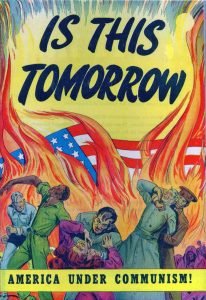
Is this tomorrow? by Catechetical Guild, Wikimedia Commons, Public Domain
| Curriculum context | Unit 2 Modern History, Area of Study 1 (VCAA, 2020) |
| Historical thinking concept/s | Continuity and change |
| Historical context | Causes of the Cold War > Ideological Differences |
| Learning intentions | Understand and be able to describe communism, liberal democracy and capitalism.
Identify and explain the differences between ideologies and why they might appeal to people. Understand the differing ideological positioning of the West (USA and Western Europe) and the East (USSR and Eastern Europe). |
Activity
In this activity you will work in groups of three and each of you will be given one of these ideologies to research. Your task is to create a poster, either digitally or by hand, which you will present to your group members to teach them about your ideology and how it contributed to causing the Cold War.
a) Research your ideology
Negotiate with your group the ideology you will research and present to one another: communism, capitalism, or liberal democracy. Undertake independent research to find out about your ideology and as you do so ask yourself if the information you are accessing is from a reliable source. As you research your ideology ensure you consider the following:
- Economic characteristics
- Political characteristics
- Social characteristics
- The world leaders who endorsed the ideology
Here are a few suggested websites to get you started:
- Ideological Conflict in the Cold War
- Communism: Karl Marx to Joseph Stalin
- Theory of Capitalism
- Liberal Democracy
b) Create a poster outlining the significant details of this ideology
You have creative freedom when creating your poster and may do so digitally or by hand.
c) Present your poster to your peers
Each person will present their poster to the group and in doing so teach their group members about the ideology they have researched.
d) In your group discuss the three ideologies considering following questions:
- Do they have any similarities?
- What are their main differences?
- How and why do these ideologies conflict with one another?
- What benefits and disadvantages are there to each ideology?
- Do you agree with each ideology? Why/why not?
References
Australian Politics (2021) Liberal Democracy, accessed 2 August 2022.
Beck E (5 March 2022) Ideological Conflict in Cold War, History Crunch, accessed 2 August 2022.
Columbia University (n.d.) Theory of Capitalism, The Centre on Capitalism and Society, accessed 2 August 2022.
University of North Carolina at Chapel Hill (2022) Communism: Karl Marx to Joseph Stalin, CES at UNC, accessed 2 August 2022.
2. Causes of the Cold War: Concept mapping ideologies
Bella Swanick
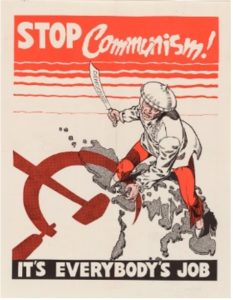
Stop Communism 1951 by The U.S. National Archives on: Picryl,Public Domain
| Curriculum context | Unit 2 Modern History, Area of Study 1 (VCAA, 2020) |
| Historical thinking concept/s | Explore historical perspectives |
| Historical context | 1945-1991 Cold War conflict between the USA and the USSR |
| Learning intentions |
|
Activity
In this activity you will be working in groups to compare the characteristics of the Cold War ideologies: communism and liberal democracy/capitalism. Each group will create a concept map on the ideology they are given.
Start by looking at this video The Cold War: Ideological Differences – Capitalism vs Communism
Step One: As individuals, write down a list of things you associate with the ideology your group has been given. Write down whatever comes to mind, the more the better!
Step Two: Now discuss with your group what you have all come up with, see if there are any differences or similarities. What questions do you both still have?
Step Three: On the paper provided write your ideology in the middle of the page. This will be the centre of your concept map
Step Four: Sort the ideas for everyone’s lists and organise them on the paper in a way that makes sense to the entire group. For example, you may decide to put the terms that were in the most lists close to the middle of the page, or organise the terms by categories (economic, political, social, significant people etc). Then look at the questions you still have.
Step Five: In your groups you need research the characteristics of your ideology and add detail to your concept map. Check the group’s initial ideas are correct.
Step Six: Explain your concept map to a group that did a different ideology.
Step Seven: Working with the two concept maps, create a venn diagram to compare the two ideologies. Also use this video Ideology of the Cold War: Capitalism vs Communism.
References
I’m stuck (2017) The Cold War: Ideological Differences – Capitalism vs Communism, accessed 18 September 2022
The Cold War (2019) Ideology of the Cold War: Capitalism vs Communism. The Cold War, You Tube, accessed 18 September 2022
3. Analysing Churchill’s Sinews of Peace (Iron Curtain) Speech
Alistair McCann

Winston Churchill – Parkeston Quay by Harwich & Dovercourt, CC BY-SA 2.0.
| Curriculum context | Unit 2 Modern History, Area of Study 1 (VCAA, 2020) |
| Historical thinking concept/s | Analyse cause and consequence |
| Historical context | The changing world order > Causes, course, and consequences of the Cold War |
| Learning intentions | Analyse Churchill’s Iron Curtain speech.
Evaluate the significance of Churchill’s Iron Curtain speech. Develop a historical argument and present in the form of a debate. |
Activity
Part 1: Source analysis
Read and watch some of Winston Churchill’s Sinews of Peace (Iron Curtain) speech and answer the following questions:
- What does Churchill mean when he says that an ‘Iron Curtain has descended across the continent (Europe)’?
- Identify reasons why Churchill may have made the speech. What was he attempting to achieve by this?
- Why did the United States and Western Europe oppose communism?
Using this source answer the following questions:
- Whose perspective is represented by the cartoon and how do you know?
- Why is important to understand which party created the cartoon?
- Identify which countries were at the most risk of adopting communism and why?
- How does this political cartoon relate to Winston Churchills ‘Iron Curtain’ speech? What is being represented by the boundary marked with the symbol of communism (hammer and sickle)?
- Evaluate the potential for the Cold War to develop into a ‘hot war’ if communism was not restricted.
Part 2: Debate
You will be separated into two groups either for or against the topic statement: ‘The United States and Western Europe were accurate in their suspicions of the spread of communism and therefore their actions to prevent the spread of communism was justified’. Prepare your group’s arguments and evidence.
References
Fitzpatrick D (2022) ‘Russia: Imperialism’, The New Imperialism, 1951, accessed 28 July 2022.
The National Archives (n.d) ‘Iron curtain’ speech, The National Archives, accessed 1 August 2022.
Westminster College (5 March 2016) ‘Sir Winston Churchill – Sinews of Peace (Iron Curtain) Speech’, Westminster College, YouTube, accessed 28 July 2022.
VCAA (Victorian Curriculum and Assessment Authority) (2020) VCE History Study Design, VCAA, accessed 28 July 2022.
4. Comparing the Yalta and Potsdam Conferences
Victoria Smart
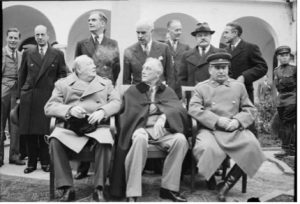
The Yalta Conference, February 1945 by Imperial War Museum, Picryl Public Domain
| Curriculum context | Unit 2 Modern History, Area of Study 1 (VCAA, 2020) |
| Historical thinking concept/s | Identify Continuity and Change |
| Historical context | Causes of the Cold War>Yalta and Potsdam Conferences |
| Learning intentions | Identify key features of both the Yalta and Potsdam conference and compare the similarities and differences.
Identify different priorities of the States involved in the conferences, in particular the USA and USSR. Condense information from different sources into a comparative table. |
Activity
In this activity you will learn about and consider the Yalta and Potsdam Conferences, the changing of perspectives of the parties and States involved over time (or how they did not change), and how these events contributed to causing the Cold War. Analyse the sources provided and then compare key features of both conferences using the table provided. You will determine what information you believe is important to record on your table. Once completed you will compare your table with a peer and justify why you thought key features you included were important and, noting any differences with your peer, justify why you omitted certain features from your table.
a) Read/view the following sources taking notes of any information you deem important:
The Big Three Conferences | Tehran, Yalta, Potsdam | WW2 Ends, Cold War Begins– (View from 3:05
b) Organise your notes into a table as the one below.
You have been provided with a few suggestions of key features to take note of, however, you must determine what other information is important. You are not limited to the five of rows provided, again, it is up to you to determine how much or little information to include to create a thorough yet succinct overview of each conference. As you decide which features to include consider the following questions:
- What was important about these conferences?
- Why or why not did certain individuals and states attend?
- Who were the conferences to benefit and disadvantage?
- Who agreed/disagreed on certain issues?
- Was there consistency or discrepancy between what was discussed at the conference and what actually occurred following the conference?
*Note that these questions should not be used as key feature headings but are to help guide you as you create your table.
| Key feature | Yalta | Potsdam |
| Dates of conference | ||
| Attendees (Important individuals, states, those who notably did not attend) | ||
| Occurrence in relation to WWII (Europe and the Pacific) | ||
c) Compare your table with a peer
There are a few purposes of sharing your table with a peer. You will:
- Practice justifying why you believe certain information is or is not important
- Observe that in the study of history people can disagree about what information is important
- Add to your own table any information you now believe is key after discussion with your peer.
References
DET (Department of Education and Training) (2021) Note-taking and summarising texts, Victorian Government, accessed 25 July 2022.
History Blast (7 July 2020) The Big Three Conferences | Tehran, Yalta, Potsdam | WW2 Ends, Cold War Begins History Blast, YouTube, accessed 1 August 2022.
University of Luxemburg (2022) The Potsdam Conference, CCVE.EU, accessed 1 August 2022.
University of Luxemburg (2022) The Yalta Conference, CCVE.EU, accessed 1 August 2022.
VCAA (Victorian Curriculum and Assessment Authority) (n.d.) Teaching and Learning Activities, accessed 25 July 2022
5. The Big Three’s perspectives
Tahlia Webb
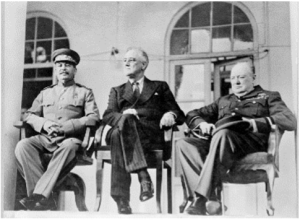
The Big Three 1943 by US Army, Public Domain
| Curriculum context | Unit 2 Modern History, Area of Study 1 (VCAA, 2020) |
| Historical thinking concept/s | Identify Continuity and Change |
| Historical context | Causes of the Cold War>Yalta and Potsdam Conferences |
| Learning intentions | Identify key features of both the Yalta and Potsdam conferences.
Compare different historical perspectives of the key leaders. Condense information from different sources into a comparative table. |
Activity
Part 1
We are beginning our investigation into the many causes of the Cold War focusing on the Yalta and Potsdam conferences that occurred in 1945. In groups of three you will pick one of the concerns listed below that were discussed by Stalin, Roosevelt, and Churchill at these conferences. You will then research the stances of the Big Three on one of these issues and fill out the table on this work sheet. Next you will script and present a re-enactment of the world leaders discussing this matter. Each group must focus on a different issue.
ISSUES:
- Reparations
- Democracy
- Atomic Bomb
- Poland
- The United Nations
| FOR/AGINST | REASONS | |
| STALIN
|
||
| ROOSEVELT
|
||
| CHURCHILL
|
Part 2
During classmates’ presentations, you are required to fill out the table below.
| ISSUE | ROOSEVELT | CHURCHILL | STALIN |
|
|
|||
References
VCAA (Victorian Curriculum and Assessment Authority) (2020) VCE History Study Design, VCAA, accessed 28 July 2022
6. Where to from WWII? The Yalta and Potsdam Conferences
Brett Fletcher

Winston Churchill, President Truman and Stalin at the Potsdam conference, 23 July 1945, by Lockyear (Capt), No 5 Army Film & Photographic Unit, Wikimedia Commons, Public Domain
| Curriculum context | Unit 2 Modern History (VCAA, 2020) |
| Historical thinking concept/s | Explore historical perspectives
Analyse cause and consequence |
| Historical context | The beginning of the Cold War > The Yalta and Potsdam Conferences |
| Learning intentions |
Revise circumstances of the post WW2 political climate. Explore the links and answer the relevant questions about the Yalata and Potsdam conferences. |
Activity
At the conclusion of the following activities, you will be asked to assume the role of an advisor to the leader of the USA or the USSR, who is tasked with conveying your suspicions and concerns regarding your new ideological adversary. You will first complete the table below to assist in recalling key knowledge and circumstances faced by key stakeholders at the conclusion of WWII. The activity then requires you to analyse the below sources to help answer questions about the Yalta and Potsdam Conferences.
Part 1
Table: Global political situation at the conclusion of WWII
| Leader at time of victory/defeat | Alliances | Mistrusts | Political system | Territory lost or gained | Casualties from the war | Notes: | |
| Great Britain
|
|||||||
| USA
|
|||||||
| USSR
|
|||||||
| Germany
|
|||||||
| Japan
|
1. Read this article, and answer the following questions about the Yalta Conference:
a) Who was present at the Yalta Conference? And who was significantly absent?
b) List and describe four matters addressed at the Yalta Conference, in order of most to least significant.
c) Which matters were agreed upon? How was this viewed by each representative?
d) Using terms found in the previous questions, conduct an online search and identify the context of the image found at Source 1. Then, complete a who, what, when, where and why report on your findings.
2. Read this article and answer the below questions about the Potsdam Conference:
a) What changes in state representation occurred between the Yalta and Potsdam Conferences?
b) What significant changes had occurred in relation to the ongoing war since the Yalta Conference?
c) What concerns had started to rise for the allies between the two conferences?
3. Now you have analysed both conferences, sort yourselves into small groups of 3-4 learners and create a Venn diagram comparing and contrasting the Yalta and Potsdam Conferences. Consider:
- Attendees/absences
- Stage of war (Europe & Pacific)
- Matters at hand
- Agreements reached
- Tensions between parties
- Outlook
Part 2
1. Using an online source/s of your own choosing, research and provide a succinct response to the below questions:
a) Why was the change in American presidents between the two conferences significant? How did this make the Potsdam Conference more polarising than the Yalta Conference?
b) Analyse the significance of the USA’s successful detonation of the A-Bomb during the Potsdam Conference. How did this impact the proceedings?
c) If there was doubt about Stalin’s intent to hold free elections in the USSR’s occupied territories, why were the allies willing to accept this promise as part of negotiations?
2. Your final task is to assume the role of a senior advisor to the leader of either the USA or the USSR. Using your knowledge and understanding of the post WW2 global political climate, you will compose a memo to your leader, outlining your suspicions towards your adversary. Ensure you avoid ‘time-travel’, you may not use events of the future as evidence to strengthen your argument. You may, however, use the benefit of hindsight to advise your leader of what you think may happen in this future ‘cold war’ so long as these suspicions are grounded in evidence available at the time of writing. You may consider in your research:
- Free elections in Poland and other Soviet satellite states
- Territory gained during WW2
- The USA’s detonation of the A-Bomb
References
The Editors of Encyclopaedia Britannica (2022) The Yalta Conference, accessed 21 July 2022.
Office of the Historian (n.d.) The Yalta Conference, 1945, Department of State, United States of America, accessed 21 July 2022.
Office of the Historian (n.d.) The Potsdam Conference, 1945, Department of State, United States of America, accessed 21 July 2022.
VCAA (Victorian Curriculum and Assessment Authority) (2020) VCE History Study Design, VCAA, accessed 15 July 2022.
7. Cuban Missile Crisis: Film and source analysis
Kevin Liew
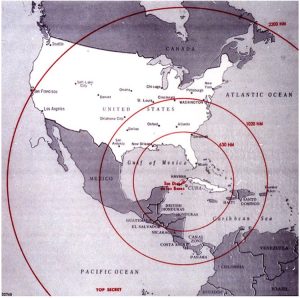
Cuban Crisis Map Missile Range by CIA Wikimedia Commons, Public Domain
| Curriculum context | Unit 2 Modern History, Area of Study 1 (VCAA, 2020) |
| Historical thinking concept/s | Using sources as evidence
Use historical interpretations |
| Historical context | The Cuban Missile Crisis |
| Learning intentions | Identify primary and secondary sources and determine their effectiveness for explaining the Cuban Missile Crisis.
Utilise primary and secondary sources to identify the causes and consequences of the Cuban Missile Crisis. Synthesise knowledge and demonstrate historical thinking concepts through a source analysis. |
Activity
In this activity, you will investigate the Cuban Missile Crisis by examining a series of primary and secondary sources. By critically analysing these sources to formulate and answer questions on the causes and consequences of the Cuban Missile Crisis, you will also evaluate its significance in influencing the Cold War and the relationship between the two superpowers: the United States of America and the Soviet Union.
Sources
Source 1: Historical interpretation of the Bay of Pigs invasion
Source 2: Kennedy’s address to the nation (0:36 – 3:11)
Source 3: A map of the missile range in Cuba
Source 4: Scene from the film Thirteen Days on the discovery of missiles (13:14-16:29)
Source 5: Cold War Arm Wrestling: A Cartoon of the Cuban Missile Crisis by Leslie Gilbert Illingworth
Source 6: Scenes from Thirteen Days : (1:03:33-1:04:01), (1:16:53-1:18:13), (1:32:45-1:33:06), (1:43:19-1:44:53), (1:47:26- 1:51:36)
Source 7: A historical interpretation of the U-2 incident over Cuba
…U.S. Air Force Major Rudolph Anderson Jr., took off… in a Strategic Air Command (SAC) U-2 on his sixth mission over Castro’s Cuba since the beginning of the Cuban Missile Crisis…”
(Whitten, 2016, p. 144)
“…he was shot down without warning by a Soviet SAM shortly before he was to exit Cuban airspace. He became the lone combat casualty of the crisis that took the U.S. to the brink of a nuclear war with the Soviet Union…”
(Whitten, 2016, p. 144)
Source 9: An excerpt from Khrushchev’s first letter to President Kennedy 26th October 1962
“Let us therefore show statesmanlike wisdom. I propose: We, for our part, will declare that our ships, bound for Cuba, will not carry any kind of armaments. You would declare that the United States will not invade Cuba with its forces and will not support any sort of forces which might intend to carry out an invasion of Cuba. Then the necessity for the presence of our military specialists in Cuba would disappear…. These thoughts are dictated by a sincere desire to relieve the situation, to remove the threat of war.”
(Alpha History, n.d.)
Source 10: Kennedy’s response to Khrushchev’s letter
- “You would agree to remove these weapons systems from Cuba under appropriate United Nations observation and supervision… to halt the further introduction of such weapons systems into Cuba.
- We, on our part, would agree – upon the establishment of adequate arrangements through the United Nations to ensure the carrying out and continuation of these commitments –
- to remove promptly the quarantine measures now in effect and
- to give assurances against an invasion of Cuba.”
(University of Groningen, n.d.)
“…I would like to say again that the United States is very much interested in reducing tension and halt the arms race…”
(University of Groningen, n.d)
Questions
- To what extent did the failed Bay of Pigs invasion contribute to the armament of Cuba? Use your knowledge of the Bay of Pigs invasion and the U.S. policy on containment to formulate your response.
- Using Sources 2 and 3, does the presence of nuclear missiles in Cuba signify a threat to the Western Hemisphere? Why or why not?
- How does the presence of missiles in Cuba shift the balance of power in the Cold War? Use Sources 3 and 4 and your knowledge of the arms race and MAD to answer the question.
- Source 8 mentions the word, “brinkmanship.” In your own words, define brinkmanship and explain how the word relates to the Cuban Missile Crisis and the Cold War as a whole.
- Analyse Sources 5, 6 and 7. How do these sources depict the tension between the USA and the Soviet Union?
- Summarise the main messages of Source 9 and 10. How are the attitudes of both President Kennedy and Khrushchev in the letters different to the tense moments of the Cuban Missile Crisis? Use the relevant sources above to make your comparisons.
- Evaluate the consequences of the Cuban Missile Crisis in influencing the Cold War and relations between the USA and the Soviet Union. Use the relevant sources and your own knowledge to answer the question.
References
Alpha History (n.d) Khrushchev’s Letter to Kennedy on Cuba (1962), Alpha History, accessed 4 August 2022.
AP Archive (2016) JFK on the Cuban Missile Crisis – 1962|Today in History|22 Oct 16, 2016, YouTube, accessed 4 August 2022.
Bolt, J. (2022) The ‘Bay of Pigs Invasion’ and the Pitfalls of U.S. Covert Action, Owlcation, accessed 4 August 2022.
Blanton, Thomas (n.d.) Annals of Brinkmanship, The National Archive: George Washington University, accessed 4 August 2022.
Donaldson, R. (2000) Thirteen Days, New Line Cinema.
The National Library of Wales (n.d.) Cold War Arm Wrestling,The National Library of Wales, accessed 4 August 2022.
University of Groningen (n.d.)President Kennedy to Chairman Khrushchev, 27 October 1962, University of Groningen, accessed 4 August 2022.
Whitten, H. W. (2016) ‘Without a Warning: The Story of the Shoot Down of a U-2 Spy Plane During the Cuban Missile Crisis’, American Intelligence Journal, vol. 33, no. 2, p. 144.
VCAA (2020), VCE History Study Design, VCAA, accessed 4 August 2022.
8. John F. Kennedy goes to the moon
Brandon Tilley
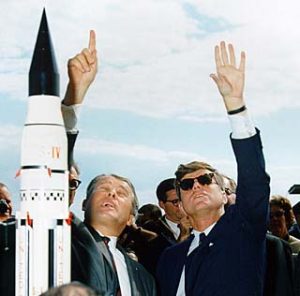
Wernher von Braun and President John F. Kennedy JFK Library, CC01.0
| Curriculum context | Unit 2 Modern History, Area of Study 1 (VCAA, 2020) |
| Historical thinking concept/s | Identify continuity and change
Establish historical significance |
| Historical context | The Cold War |
| Learning intentions | Use guiding questions to analyse primary sources.
Develop understanding of how political ideologies drive social, economic and cultural change. Develop understanding of Cold War ideologies. |
Activity
In this activity you will study John F. Kennedy’s Address before the 18th General Assembly of the United Nations. You will develop an understanding of how ideology, technology, competition and even cooperation helped shape the dynamics of the Cold War by analysing his ideas and of the historical context of this speech and the space programme it helped launch.
Explore historical perspectives
‘Comprehending the past involves consideration of how historical actors understood their world. Historical thinking involves making judgments by analysing, within their context, the actions, beliefs, values and attitudes of people in the past. Identifying and comparing different historical perspectives develops an understanding that perspectives were different in the past and that these mindsets may differ from those of the present. Historical perspectives are often found in primary sources. In order to make use of primary sources as evidence, they must be critically evaluated’ (VCAA 2021:6).
Historical context
- Begin by watching Matthew Jordan’s TED-Ed presentation on The History of the Cuban Missile Crisis, the series of events that transpired in October, 1962, after a U-2 spy plane discovered that USSR Premier Nikita Khrushchev had positioned Soviet missiles in Cuba, just 100 miles from US shores. What is President Kennedy’s overall message to the American people? Take some notes on key statements he makes in this speech.
Content
- Print this transcript of the UN Address, and have it on your desk as you watch John F. Kennedy’s Address before the 18th General Assembly of the United Nations.
- As you listen to the speech, mark the major “pivot points” in Kennedy’s speech. What is the main topic in each section of the speech. Using different colour highlighters, mark where each new topic begins, and make a brief note in the margin of the transcript to indicate each new topic.
- What role does Kennedy think the United Nations should play in global politics?
- What opportunities for cooperation between the US and the USSR does Kennedy propose in this speech?
Reflection
- In small group, discuss any similarities you see between the ideas in President Kennedy’s speech and the present.
References
Jordan, M (2016) The history of the Cuban Missile Crisis, TED-Ed, accessed 11 August 2022.
Kennedy, JF (1963) Address before the 18th Assembly of the United Nations, accessed 11 August 2022.
Kennedy, JF (1963) Address before the 18th Assembly of the United Nations transcript, accessed 11 August 2022.
VCAA [Victorian Curriculum and Assessment Authority] (2020) VCE History Study Design, accessed 5 August 2022.
9. Causes of the Vietnam War
Nicholas Bridges
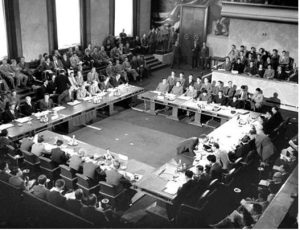
The Geneva Conference Wikimedia Commons, Public Domain
| Curriculum context | Unit 2 Modern History, Area of Study 1 (VCAA, 2020) |
| Historical thinking concept/s | Explore historical perspectives |
| Historical context | Causes of the Vietnam War |
| Learning intentions | Identify causes of the beginning of the Vietnam War.
Decipher and discuss the decisions of major players in the war. Demonstrate lower and higher order thinking. Use sources to find, summarise and explain relevant information. |
Activity
Provide short answer responses to these questions. Everyone should begin by answering the three ‘mild’ questions to get an overarching view of the causes of the Vietnam War. Following this, choose either the ‘medium’ questions or the ‘hot’ questions if you would like more of a challenge. Some sources of information have been provided for each question.
| Question One | Question Two | Question Three | |
| ‘Mild’ | Q1 Summarise the rise of communism in North Vietnam through the 1950s and early 1960s. What were the main events? Who were the main players?
Source: Vietnam War timeline: 1955 to 1959 (Alpha History 2018) and Vietnam War timeline: 1960-1964 (Alpha History 2018)
|
Q2 Provide a timeline of major United States policy decisions relating to Vietnam prior to August 1964.
Source: Vietnam War timeline: 1955 to 1959 (Alpha History 2018) and Vietnam War timeline: 1960-1964 (Alpha History 2018)
|
Q3 Why was the National Liberation Front (NLF) formed, and what methods did they use to try and achieve their goals?
Source: The Viet Cong (Alpha History 2019)- from ‘The National Liberation Front’ onwards |
| ‘Medium’ | Q1 Analyse JFK’s comments in this 1956 Speech – how do they foreshadow his subsequent presidential decisions in relation to Vietnam?
Source: JFK Speech: America’s Stake in Vietnam (State Historical Society of Iowa n.d.) and John F. Kennedy: Vietnam War (Alpha History 2018) |
Q2 Compare and contrast the views and decisions of LBJ with those of JFK in relation to Vietnam.
Source: Lyndon Johnson: Vietnam War (Alpha History 2019) |
|
| ‘Hot’ | Q1 Evaluate the success of the Geneva Accords of 1954. What were they intended to achieve? Did they have any chance of success? Why or why not?
Source: The Geneva Accords of 1954 (Alpha History 2019)
|
Q2 Could the Vietnam War have been avoided? Or did the circumstances render it inevitable?
Source: Historians and the Vietnam War (Hopkins 2000)
|
References
Alpha History (2018) ‘John F. Kennedy: Vietnam War’, Alpha History, accessed 20 July 2022.
Alpha History (2018) ‘Vietnam War timeline: 1955 to 1959’, Alpha History, accessed 19 July 2022.
Alpha History (2018) ‘Vietnam War timeline: 1960-1964’, Alpha History, accessed 19 July 2022.
Alpha History (2019) ‘Lyndon Johnson: Vietnam War’, Alpha History, accessed 20 July 2022
Alpha History (2019) ‘The Geneva Accords of 1954’, Alpha History, accessed 22 July 2022
Alpha History (2019) ‘The Viet Cong’, Alpha History, accessed 29 July 2022.
Hopkins GW (2000) ‘Historians and the Vietnam War: The Conflict Over Interpretations Continues’, Studies in Popular Culture, 23(2):99-108.
State Historical Society of Iowa (n.d.) Transcribed Excerpts from “America’s Stake in Vietnam” Speech by U.S. Senator John F. Kennedy, June 1, 1956, accessed 21 July 2022
Victorian Curriculum Assessment Authority (2020) VCE History Study Design, accessed 20 July 2022.
10. The Gulf of Tonkin Incident: Understanding the causality of events in the Cold War context
Nick Frawley

USS Hornet (CVS-12) underway in the Gulf of Tonkin on 5 September 1967 by United States Navy, Wikimedia Commons, Public Domain
| Curriculum context | Unit 2 Modern History, Area of Study 1 (VCAA, 2020) |
| Historical thinking concept/s | Analyse cause and consequence |
| Historical context | The Cold War > Proxy wars and conflicts that reflected the consequences and divisions > The Vietnam War |
| Learning intentions |
|
Activity
In this activity you will collect information about the Tonkin Incident while viewing a video and then analyse it using this cause and consequence chart template.
a) Watch this video, The Gulf of Tonkin Incident (1964) detailing the events at the Gulf of Tonkin that preceded America’s active involvement in the Vietnam War
Whilst watching the video, answer these questions:
- What countries were involved in the Gulf of Tonkin incident?
- Why was the United States concerned with aggression in the area of the incident?
- What miscommunication added to the expansion of the conflict?
- What was the reason given for the US Navy potentially misreading the events?
- Based off of the events depicted in the video, do you think this is enough motive to enter into a war?
b) Using this cause and consequence chart template, show how Americans firing on the North Vietnamese led to sequential events leading into the Vietnam War.
References
Global Education (2012) Consequences Chart. Commonwealth of Australia. Accessed 10 August 2022.
Simple History (2017) The Gulf of Tonkin Incident (1964). Simple History, You Tube. Accessed 10 August 2022.
11. The Berlin Wall: Jigsaw activity and concept map
Annaliese Magee
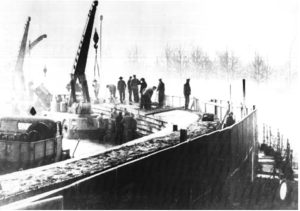
East German construction workers building the Berlin Wall, 20 November 1961 by National Archives Wikimedia Commons, Public Domain
| Curriculum context | Unit 2 Modern History, Area of Study 1 (VCAA, 2020) |
| Historical thinking concept/s | Cause and consequence
Change and continuity |
| Historical context | The Cold War and division of Germany and Berlin |
| Learning intentions | Become an expert in one of the five topics and explain it to peers.
Communicate the causes and consequences in regard to the rise and fall of the Berlin Wall. Explain how social and cultural conditions changed and/or stayed the same. |
Activity
Part 1: Jigsaw activity
In this jigsaw activity you will start in a home group, then become an expert on a certain topic relating to the Berlin Wall and then return to teach your home group about what you found out.
a) Watch The rise and fall of the Berlin Wall to get an overview and view this pictorial timeline In pictures: 25 years since the fall of the Berlin Wall
b) You are to choose a home group of five then number yourselves 1-5. From there you will be assigned one of the five groups below. Go to a table with the other students with the same number. Then you and the group become an expert group on that topic number:
- The long-term causes of the division of Germany and Berlin
- Reasons/causes for the construction of the Berlin Wall
- Consequences for those who lived in West Germany (FRG) in 1945-1989
- Consequences for those who lived in East Germany (GDR) in 1945-1989
- The cause and consequence of the fall of the Berlin Wall in 1989
c) Research together, gathering information and references for the sources you use. Create a short set of slides you can each use to teach your home group.
d) Go back to their original home group and each present your slides.
Part 2: Concept map
This activity builds on from the previous activity by categorising the types of consequences of the construction and destruction of the Berlin Wall using a concept map. Create a concept map based on the example below and identify at least three examples of short and long term social, political and economic consequences for both sides of the Wall. You could draw your concept map more creatively by drawing a wall.
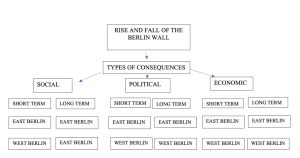
References
Jarausch, K. H (2017) The rise and fall of the Berlin Wall. TED-Ed Your Tube. Accessed 13 September 2022.
ABC (2014) 25 years since the Fall of the Berlin Wall. ABC News. Accessed 13 September 2022.
12. Vietnam War song analysis and record cover activity
Hannah McArdle

Record player by by Jace & Afsoon on Unsplash
| Curriculum context | Unit 2 Modern History, Area of Study 1 (VCAA, 2020) |
| Historical thinking concept/s | Use primary source evidence
Explore historical perspectives |
| Historical context | Vietnam War |
| Learning intentions | Analyse anti-war movement historical sources.
Utilise knowledge of two anti-war movement sources to produce an album cover and song review.
|
Activity
In this activity you will analyse two sources– an image relating to anti-war protest and a song relating to the Vietnam War. You will present your analysis in the form of an album cover and song review.
- Choose a song from the list below; this will be the record you make the album cover art for. Listen to the song, find out when it was recorded and read the lyrics. What messages and images are evident in the lyrics? Use the questions below to guide your analysis.
- What’s going on – Marvin Gaye
- We gotta get out of this place – The Animals
- Khe sanh – Cold Chisel
- I was only 19 – Redgum and The Herd
- Saigon Bride – John Baez
- Eve of Destruction – Barry McGuire
- Born in the USA – Bruce Springsteen
- Singing in the Vietnam blues – Johnny Cash
- Backlash Blues – Nina Simone
2. Choose an anti-war movement image from the sources listed below; this will be a part of the cover art for your album cover. Be as creative as you like when creating your front cover art but make sure the image you choose is copyright compliant–it must be in the public domain or have a Creative Commons licence. Chose an Australian image for an Australian song and an image related to the US for an American song.
Sources of copyright compliant images:
Australian War Memorial Vietnam photos (check copyright status of each image before using)
Search Google images using the Creative Commons search tool
3. Analyse the photo and song by completing a review on the back of the album cover. Use the questions below to guide your analysis.
Questions to guide your song and image analysis:
The VCAA has created this source analysis framework to help us evaluate sources (VCAA, 2021:6).
| What is the source?
(Content) |
What information can be determined? What meanings are evident?
|
| Who made it?
(Content) |
Who is the author? What point of view is evident here? |
| When/Where?
(Content) |
Where does the source come from? When was it made? |
| What is its context?
(Historical Context) |
What else was happening at the time the source was made? |
| Why was it made?
(Purpose) |
Who is the source likely made for? What is its purpose? |
References
VCAA (2022) Advice for Teachers. Victorian Curriculum and Assessment Authority. Accessed 1 August 2022
13. Key moments in the Cold War: Peer teaching activity
Kostantinos Georgiou
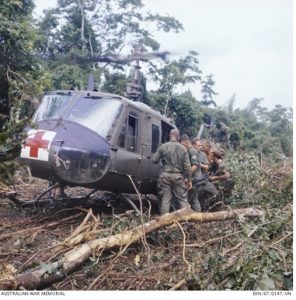
South Vietnam. 1967. An American medical evacuation ‘dustoff’ helicopter takes aboard a casualty Australian War Memorial, Public Domain
| Curriculum context | Unit 2 Modern History, Area of Study 1 (VCAA, 2020) |
| Historical thinking concept/s | Analyse cause and consequence
Establish historical significance |
| Historical context | The Cold War |
| Learning intentions | Research and answer questions in a presentation format.
Develop an understanding of their group’s historical context and other groups’ historical contexts. |
Activity
For this group activity, you will break up into five different groups and each group will be assigned one historical context/key event of the Cold War:
1) The Berlin Blockade
2) The Korean War
3) The Cuban Missile Crisis
4) The Vietnam War
5) The Chernobyl Disaster
Your task is to become experts on your event and create a presentation that you will use to teach your peers about it. The presentation will answer several general questions about the event. All sources of information and images must be referenced using the Harvard system.
Questions
1) Discuss what took place in the lead up to your group’s event. What triggered it?
2) Outline the events that took place in your group’s key event.
3) Consider perspectives:
a) How did the West (United States/NATO) handle the situation, and if they were not directly involved how did they respond to it?
b) How did the East (Soviet Union) handle the situation, and if they were not directly involved how did they respond to it?
4) How was the event resolved, and if it was not, then what was done to try resolve it and why did it fail?
5) How did the key event contribute to the Cold War immediately and over the course of the Cold War?
Source to get started:
- Encyclopedia Britannica: Berlin Blockade
- Alphahistory: The Berlin Blockade
- Encyclopedia Britannica: Korean War
- Alphahistory: The Korean War
- Encyclopedia Britannica: Cuban Missile Crisis
- Alphahistory: The Cuban Missile Crisis
- Encyclopedia Britannica: Vietnam War
- Alphahistory: The Vietnam War
- Encyclopedia Britannica: Chernobyl Disaster
- Alphahistory: Stagnation in the Soviet Union – see Chernobyl
References
Encyclopedia Britannica (2022) Chernobyl Disaster Encyclopedia Britannica Inc, accessed 4 August 2022.
Encyclopedia Britannica (2022) Berlin Blockade Encyclopedia Britannica Inc, accessed 4 August 2022.
Encyclopedia Britannica (2022) Cuban Missile Crisis Encyclopedia Britannica Inc, accessed 4 August 2022.
Encyclopedia Britannica (2022) Vietnam War Encyclopedia Britannica Inc, accessed 4 August 2022.
Encyclopedia Britannica (2022) Korean War Encyclopedia Britannica Inc, accessed 4 August 2022.
Llewellyn J. & Thomson, S (2020) The Berlin Blockade Alphahistory, accessed 4 August 2022.
Llewellyn J. & Thomson, S (2020) The Cuban Missile Crisis Alphahistory, accessed 4 August 2022.
Llewellyn J. & Thomson, S (2020) The Korean War Alphahistory, accessed 4 August 2022.
Llewellyn J. & Thomson, S (2020) Stagnation in the Soviet Union Alphahistory, accessed 4 August 2022.
Llewellyn J. & Thomson, S (2020) The Vietnam War Alphahistory, accessed 4 August 2022.

